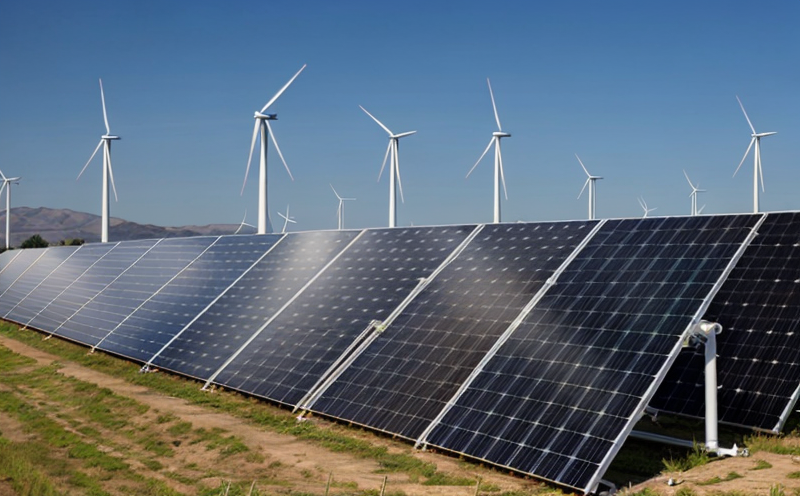IEEE 519 Harmonic Distortion Compliance Testing in Renewable Systems
The IEEE Standard 519-2014, "Recommended Practice for Power Quality and Voltage Disturbances in Electrical Power Systems," is a crucial document that sets the guidelines for harmonic distortion within power systems. This standard ensures that electrical equipment operates efficiently and reliably under specified conditions of harmonics. Harmonic distortion can arise from non-linear loads such as inverters used in renewable energy systems, which can lead to voltage distortions, increased losses, and potential damage to sensitive devices.
In the context of renewable energy systems, particularly solar photovoltaic (PV) systems, wind turbines, and other grid-connected generators, compliance with IEEE 519 is essential. These systems often generate harmonics due to their non-linear characteristics during both steady-state and transient conditions. Non-compliance can result in penalties from utility companies, increased maintenance costs, reduced system efficiency, and even premature equipment failure.
The testing process for IEEE 519 compliance involves several key steps. Firstly, the harmonic content of the power supply must be measured under various operating conditions to determine whether it meets the specified limits set forth in the standard. This includes both fundamental frequency components (F0) and higher-order harmonics up to the 21st order.
The apparatus used for this testing typically includes advanced power analyzers capable of capturing high-resolution data over extended periods. Specimen preparation involves ensuring that all connected devices are properly configured according to manufacturer guidelines, especially inverters and converters which are primary sources of harmonic generation in renewable systems. Reporting must adhere strictly to IEEE 519 standards, providing detailed insights into any deviations from acceptable levels.
The compliance test aims not only at protecting the integrity of the grid but also ensuring that connected devices function optimally without causing disturbances back to the utility network. By adhering to these stringent requirements, operators can maintain high-quality power delivery while minimizing environmental impact through more efficient energy conversion processes.
| Harmonic Order | Acceptance Criteria (%) |
|---|---|
| Fundamental (F0) | <5% |
| 2nd to 19th Harmonics | <4% for individual harmonics, <6% total harmonic distortion (THD) |
| 21st and Higher Order Harmonics | <0.5% |
Why It Matters
Complying with IEEE 519 standards is critical for several reasons:
- Ensures reliable operation of renewable energy systems by minimizing harmonic distortion.
- Avoids potential penalties imposed by utility companies due to poor power quality.
- Prolongs the lifespan of connected devices, reducing maintenance costs and downtime.
- Maintains grid stability and reduces voltage fluctuations that could otherwise affect other components on the network.
Non-compliance can lead to significant operational issues such as overheating in transformers, increased switching losses in power distribution systems, and even tripping of protective devices. By adhering to IEEE 519 standards, operators ensure their installations meet industry best practices, enhancing both performance and longevity.
Industry Applications
IEEE 519 compliance testing is applicable across a wide range of industries where renewable energy systems are deployed. Here are some key sectors:
| Sector | Description |
|---|---|
| Solar Photovoltaic (PV) Systems | Testing ensures grid compatibility and efficiency. |
| Wind Turbine Farms | Reduces the impact of harmonics on surrounding power systems. |
| Hydropower Plants | Maintains optimal water flow through efficient operation. |
| Battery Storage Systems | Enhances battery performance and lifespan. |
| Microgrids | Safeguards microgrid stability and reliability. |
| HVDC Transmission Networks | Avoids interference with other high-voltage transmission lines. |
| Electric Vehicle Charging Stations | Guarantees safe and efficient charging without degrading power quality. |
By ensuring compliance with IEEE 519, these systems can operate more efficiently, thereby contributing to a cleaner and more sustainable energy future.
Why Choose This Test
- Regulatory Compliance: Ensures adherence to international standards, avoiding potential legal issues.
- Enhanced Reliability: Minimizes downtime and maximizes system availability.
- Better Efficiency: Reduces energy losses due to harmonic distortions.
- Environmental Impact Reduction: By maintaining cleaner power quality, it contributes towards reducing greenhouse gas emissions.
- Customer Satisfaction: Provides peace of mind knowing that the system meets all necessary requirements.
- Potential Cost Savings: Avoids costly repairs and replacements caused by suboptimal performance due to harmonic distortions.
These benefits make IEEE 519 compliance testing an indispensable part of any renewable energy project lifecycle, from design through installation and operation.





